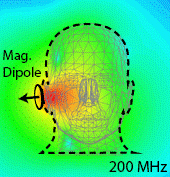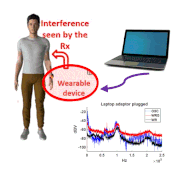Channel Characterization of Magnetic Human Body Communication
https://www.embs.org/tbme/wp-content/uploads/sites/19/2022/02/TBME-00150-2021-Highlight-Image.gif
170
177
IEEE Transactions on Biomedical Engineering (TBME)
//www.embs.org/tbme/wp-content/uploads/sites/19/2022/06/ieee-tbme-logo2x.png
This paper aims to validate, analytically and experimentally, the benefits of the magnetic human body communication (mHBC) method using small form-factor-accurate antennas operating under realistic conditions. We show that by adopting resonant coils that couple by magnetic-dominant near-field at a few hundreds of MHz, low path loss and extra robustness to antenna misalignment across the body can be achieved compared to conventional far-field RF schemes. In best-case scenarios, the mHBC channel exhibits 100000x better efficiency than Bluetooth utilizing antennas of similar sizes. The extremely high efficiency provides a potential solution to the ever-present energy problem for miniaturized wearables.
read more


